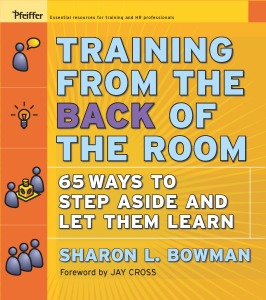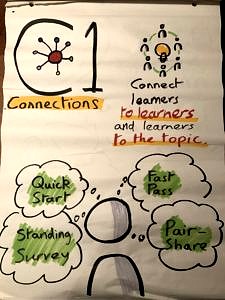Psychological safety is a big deal, both in the real world and the virtual one. I know I struggle to feel safe, especially on social media at times. I have lost count of the number of posts and tweets that I have written, only to decide that maybe today is not the right time to pop my head over the parapet and risk it. I’m sure I’m not alone in this.
In this post I’m not going to discuss how to create psychological safety in the virtual or working worlds. Instead, I’ll talk about something that is close to my heart: Sharon Bowman‘s “Training from the BACK of the Room!” (TBR). Specifically, I want to address how TBR builds Psychological Safety in the training space where safety is often lost.
 My Introduction to TBR …
My Introduction to TBR …
I first encountered Training from the BACK of the Room! when my colleague José Casal raved about a course he had attended with Rolf Katzenberger.José said he felt like he’d “levelled up” as a trainer. Intrigued, I bought the TBR book. A short while later, I found myself on my annual summer break, sitting by a pool in Mallorca, reading Sharon’s book. I wrote in it, stuck tabs on it and covered it in oily finger prints from my sun-lotion covered hands.
I remember thinking about how our whole approach to education for both children and adults needs a rethink based on the topics in the book. All of the exercises and ideas were awesome and I thought I knew how to make training design and delivery really work.
When I got back home, I got a call from a consultant about helping to design a Scrum course using ideas from the book. So we did. We included some really cool activities and thought that we had nailed the psychological safety aspect too. It is safe to say that we were quite pleased with our work.
(NOTE: If you want an introduction to TBR, click HERE for a brief overview of the TBR concepts.)
Best Laid Plans …
The first morning, we opened the course with a Low-Tech Social Network that was our “Connection” activity (C1 in TBR parlance). The C1-Connection activity is supposed to make everyone feel psychologically safe with each other.
I invited everyone to draw avatars and a little bit of profile information on an index card. Then I asked them to place their card on a poster on the wall and introduce themselves from the card.
Inevitably, the more confident people in the session jumped up to announce themselves to the room. As it got to the less confident people I noticed something odd. More and more nervousness crept in. In one case, the nervousness was so palpable, the attendee couldn’t get away from the poster fast enough. They had totally shut down and there was nothing I could do about it.
What had happened? I thought I had created a safe C1-Connection activity, yet it hadn’t worked out that way. Mercifully, within about 30 minutes, the nerves had passed and the rest of the course was a success. But what had gone on at the beginning?
Reading the TBR Book Versus Attending the Class …
In October 2015, I attended a TBR Practitioner Class with Sharon Bowman in Sacramento, California. It was an incredible 2-day experience. I thought my poolside musings from reading the book had been transformative, but they weren’t even a close second to attending the class in person. It quickly became clear that my idea of a C1-Connection was out of whack with what it is really there for.
A Question for You …
Before I explain what a C1-Connection really is, let me pause here and ask you, the reader, a question. I’d like you to think of a time when you have attended a workshop or a course where the instructor directed you to do an introductory “ice-breaker.” For example, “Interview the person next to you and then you’ll introduce them to the rest of the group”. Or worse still, “Let’s go round the room — please state your name, job role and a why you are here”.
How did that ice-breaker make you feel? Can you remember a single thing that anyone else said? Did the activity make you feel connected to the other learners or to the topic of the class? Did it make you feel safe?
I don’t know about you, but when the introductions go around the room, I usually spend the entire time thinking about what I am going to say. Afterwards, I’m then so relieved after I’ve had my turn that I don’t listen to anything that the remaining participants say. Not what I’d call an effective opening activity! It’s one of the Anti-Patterns of Training I previously highlighted called “Too far out of my comfort zone”.
 The purpose of C1-Connections …
The purpose of C1-Connections …
An “ice-breaker” is just a social activity at the beginning of a class or training that usually doesn’t have anything to do with the topic. An ice-breaker may or may not connect learners to each other in a meaningful way, and it might not create psychological safety among learners in a class group.
In contrast, the purpose of a C1-Connection activity is to connect learners to each other and to the topic in ways that make most learners feel psychologically safe in each other’s presence.
Put simply, a C1-Connection activity:
- Connects learners to the topic through some sort of discussion.
- Connects learners to each other in a psychologically safe way as in a paired or triad discussion.
The beginning of a TBR-styled course utilizes activities and content that do these 2 things. With one or more C1-Connection activities, we prepare people to learn. We help learners become comfortable with the peculiar environment that is a formal classroom or training room (usually a roomful of strangers).
Because the C1-Connection activities are structured in warm and friendly ways, the learners begin to feel safe with each other. And, of course, because the activities are topic-related, learners are also sharing information about the content of the course.
In addition, if a C1-Connection activity involves a bit of movement (e.g., standing, walking), all the better for burning off any excess adrenalin! This, too, builds psychological safety.
Personally speaking, C1-Connection activities have forever changed the way I deliver training. C1-Connection activities are magic! The camaraderie in the class builds, the energy in the room increases, and the potential for successful learning is greater. The larger the group’s comfort zone becomes, the greater their learning experience and knowledge acquisition will be.
An Easy and Effective C1-Connection Activity …
A really effective C1-Connection activity is the Quick Start. The instructions are simple:
Before the class begins, put up a slide, a white board or a poster with some instructions. The instructions direct learners to introduce themselves to one person seated near them and to discuss what they already know about the training topic. As learners enter the classroom or training room, they read the instructions and off they go.
The Quick Start gives learners something topic-related to talk about. They are in pairs, which is more comfortable than having to speak in front of the whole class. And the activity engages everyone at the same time so that no one person is singled out (an important element of psychological safety).
During the Quick Start, you, as the trainer, walk around the room watching and listening. You learn which participants already know a lot about the topic. This is great information to have.
You can also learn the participants’ names by studying their name badges. And you’re not putting the class through the excruciating experience of introducing themselves to the whole group, one at a time (leave that for people who haven’t learned that there’s a better – and more psychologically safe – way to connect learners to learners!).
Conclusion …
It’s sad that our education system has done a lot of damage to some who have passed through it. We all remember the best teachers that we had at school, but we also remember those who should never have been allowed within a 100 meters of a school too.
I once had an attendee who openly expressed gratitude that they now understood why going to training always filled them with dread… it was because they’d had a terrible time at school. They’d never connected those 2 things until attending a TBR Practitioner Class and learned the power of a C1-Connection.
Whenever I deliver a TBR Practitioner Class or a course designed from the ground up with TBR methods, I always hear stories like this which make me realise how worthwhile the TBR concepts and strategies are for any kind of learning experience.
So the next time you are tempted to begin a training, course, or workshop with an ice-breaker, reflect on whether or not the activity creates psychological safety for all learners. Consider using a C1-Connection activity like the Quick Start instead, in order to create that feeling of safety and connection among learners from the very beginning.
In future blog posts, I’ll cover two other strategies that create psychological safety: the “Right to Pass” and “Movement Trumps Sitting.
If you would like to learn more, consider attending one of our “Training from the BACK of the Room” (TBR) Practitioner Classes.

****************************
 About TBR Certified Trainer Jean-Paul Bayley …
About TBR Certified Trainer Jean-Paul Bayley …
TBR Certified Trainer Jean-Paul Bayley resides in England and is a partner of Actineo Consulting LLP, a Business Agility Consultancy. Jean-Paul thrives on the fizz and pop of a training group in full flow. His mission is to share how to create fun, engaging and memorable learning experiences. Using the skills that he has honed during his career as a consultant, coach, and trainer, he helps individuals, teams, and organizations achieve their professional goals. Be sure to read his other blog posts on Sharon’s website: 3 Anti-Patterns of Training and Anti-Patterns of Training – Part Two. You can follow him on Twitter @jpbayley.
And a belated thanks back, Deborah, for your kind comments. Hope all is well in your world – cheers to you and yours! Sharon
Great post — helpful reminders and an acknowledgement of how uncomfortable people can and often do feel at the beginning of training! Thank you.